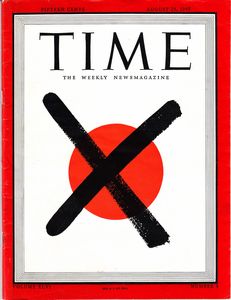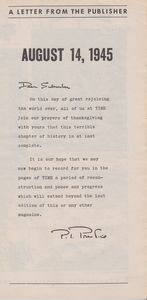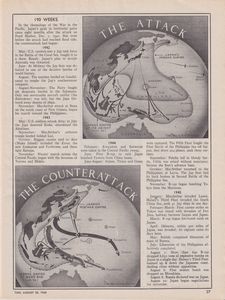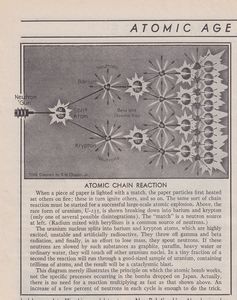Japan surrenders
| série: | 2nd WW Pacifique |
| éditeur: | Time Magazine |
| auteur: | Collectif |
| classement: | dossier724 |
| année: | 1945 |
| format: | broché, issue 20.8.1945 |
| état: | TBE |
| valeur: | 100 € |
| critère: | *** |
| remarques: | volume XLVI, no 8 20.8. 1945 issue rare and very expensive preface: a letter from the publisher (see enclosure) victory / the peace 1) the bomb the greatest and most terrible of wars ended with an event so much more enormous that relative to it, the war itself shrank to minor significance: the controlled splitting of the atom, but this could also end all wars if only man would learn its control and use 2) the surrender the Japanese imperial issue was the issue of the Pacific peace, the Emperor being Japan >> p. 21 the answer of president Truman to the Takyo offer of capitulation 14.8.1945 on 8.8.1945 Russia had declared war to Japan and after 4 days of a long wait, Japan confirmed surrender unconditionnally 3) the people the celebration of the victory had tragic consequences: 6 killed and 30 wounded world battlefronts - the Kwantung army in Northern China commanded by general Yamada was no match for the Red Army which could quickly occupy Mandchuria - Hiroshima (6.8.) and Nagasaki (9.8.) atom bombs, on 10.8. Japan started negotiations - Japan on 10.8. had still 5 mio soldiers under arms spread in Mandchuria, China, Indochina, Singapore, Indonesia and some Pacific islands Atomic Age the USA won the race of discovery but the responsability is now awful, TNT is barely twice as strong as black powder, explosives used during 2nd WW were 60% more powerful than TNT but the atom bomb is 12'000 times as strong as these explosives; 123 planes with each an atom bomb would cause as much destructive power as all the bombs dropped in Europe during the war the atom bomb can destroy so much faster than the victims could rebuild and surrender is the only possible result, the Big Three with atomic power (USA, Canada and Great Britain), France was frustrated not being added to the atomic club, however in 5 years' time a strong nation could be in a position to get the bomb and it is of no use to build more bombs when 500 has the same effect than 50'000! Atomic chain reaction (technology) >> for more details see pages 30-36 of the magazine, summary hereof: like paper lighted set fire on other paper particles, the same sort of chain reaction must be started for an atomic explosion, the Uranium U-235 nucleus (particle made of neutron or proton being the core of the atom = nucleus) will break into barium and krypton which on their turn in a tiny fraction of a second will produce further good-sized sample of neutrons and trillion of atoms resulting in a cataclysmic blast Rutherford (1919) first succeeded in splitting the atom, Becquerel (1896) discovered radioactivity (= spontaneous release of atomic energy); 1898 Pierre and Marie Curie discovered the radium (atom no 88 = extremely radioactive when losing their mass by releasing electromagnetic emissions) the neutron is the trigger of the atomic bomb fission = the uranium atom so broken into 2 nearly equal fragments 1905 Einstein discovered the equation E = mc2 = energy is equal to mass multiplied by the square of the velocity of light; light speed is so enormous (186'000 miles a second) and its square (self-multiplication) so much more enormous still that one pound of matter is equal to more than 2 billion kilowatthours of energy 1942 British and US physicists made a plan to work together under the authority of the US army, it was the Manhatten project; it was discovered that slow-moving neutrons could split the atoms of the uranium 235 giving a mighty rush of energy plutonium made out of uranium 238 can absorb instead of splitting and used as a combustible, its radioactivity ist very high, U235 and plutonium do not need a detonator, they explode automatically, whenever gathered together in large quantities N.B. - kilowatthour = energy produced by a machine of 1 kilowatt during one hour - kilowatt = 1000 watt - 1 watt = energy equal to one joule during one second - joule = energy equal to one newton pushed during one meter - newton = energy equal to a mass of 1 kg propulsed by an acceleration of 1m/s2 (meter per square second) foreign news Japan: it was a fact that Japan was at the end of its 8 years' war, even before bombing, the strain on its productive system - no match for the great western powers - must have been terrific; the people conditions have been dismal, health conditions are wretched, rationing is strict (no beef only dog and horse, very few fish and chicken, no beer, everybody raises vegetables) and the fuel situation is very tight China: as soon as Japan's capitulation was known, there was an open challenge by the communists to the Central Government of Chiang Kai-shek, the issue of civil war hung precariously in the balance, Korean independance League now emerges also and demands a new democratic Korean republic Germany: suicide wave reported France: trial of Mme Pétain (67) and Mme Laval (57) together with the trial of maréchal Pétain Austria: restored to its original frontiers, divided into 4 war-zones: Russia (Vienna), Great Britain (Klagenfurt), USA (Salzburg) and France (Innsbruck) Science the radar: now an electronic supergadget, radar is probably as important as atomic power itself radar was chiefly responsible for defeating U-Boat and the buzz bomb (V1), radar with 300 RAF pilots won the battle of Britain >> p. 78-82 the history of radar, pioneers and progress Business without American production, the United Nations (the Allies) could never have won the war, production of the last 5 years: - 300'000 combat planes - 3,6 mio trucks - 100'000 tanks - 87'600 war ships (including landing craft) - 44 bio rounds of ammunition now the US industry have to be reconversed >>> a super Time magazine with very interesting and detailed articles, especially: - development of the Pacific war - development of Japanese negotiations - the atomic age - the radar |
| couvertures: |     |
Copyright 2008 - 2025 G. Rudolf
